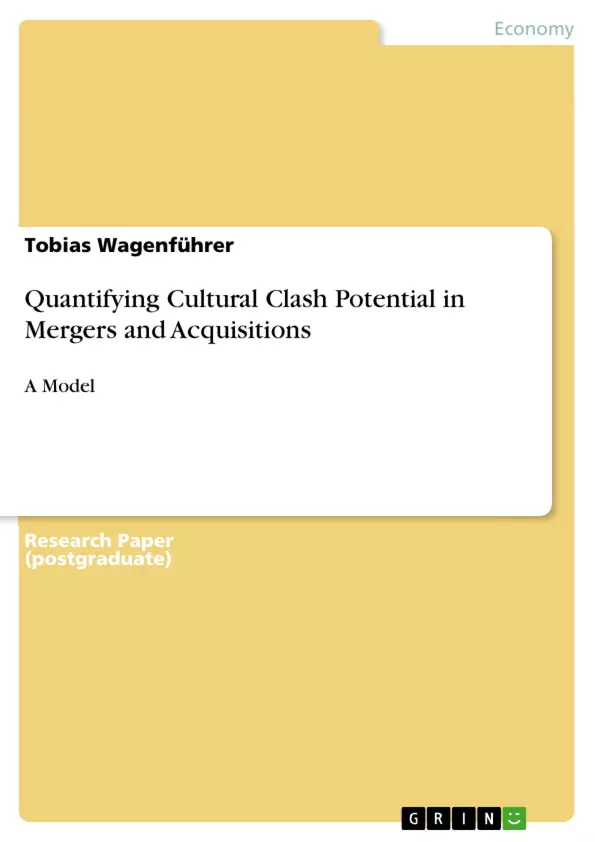Recent merger waves have shown that the awareness of and appropriate
reaction to cultural differences between transaction partners can be the crucial element that decides on their success or failure. Previous research has never made an effort to quantify cultural risks, and in a second step, costs of Mergers and Acquisitions (M&A).
This paper aims at developing a model that gives an indication of the conflict potential inherent to the cultural differences between transaction parties. The model shall also disentangle which culture type – national, corporate, professional, individual or deal culture – is most likely to clash, and which cultural elements are the determinants of that hazard. The model can be viewed as an early-stage tool that lays the groundwork for the development of cultural cost estimation instruments for M&A.
Inhaltsverzeichnis (Table of Contents)
- Introduction
- Chapter One - Theoretical Framework
- Part One - National Culture
- Part Two - Corporate Culture
- Part Three - Professional Culture
- Part Four - Individual Culture
- Part Five - Culture of the Deal
- Chapter Two - A Scoring Model
- Part One - Basis of the Scoring Model: Elements and Scales
- Part Two - Core of the Scoring Model: Weighing of the Elements
- Part Three - Potentials and Limitations of the Model
- Chapter Three - Consequences of Cultural Differences
- Chapter Four - Case Study Daimler Chrysler
Zielsetzung und Themenschwerpunkte (Objectives and Key Themes)
This paper aims to develop a model that quantifies cultural risks and costs associated with Mergers and Acquisitions (M&A), particularly in cross-national transactions. The model will identify the specific cultural dimensions most likely to cause conflict and provide insights into their impact on the success of M&A.- Cultural Risks in Mergers and Acquisitions
- Impact of Different Cultural Dimensions on M&A Success
- Development of a Scoring Model to Assess Cultural Fit
- Application of the Model to Identify and Mitigate Cultural Conflicts
- Case Study of DaimlerChrysler to Illustrate Model Application
Zusammenfassung der Kapitel (Chapter Summaries)
- Introduction: This chapter introduces the growing trend of cross-national M&A activity and highlights the increasing attention given to cultural differences as a factor in M&A success. The paper's objective is to develop a scoring model that assesses cultural fit and identifies potential conflict areas.
- Chapter One - Theoretical Framework: This chapter provides a comprehensive review of the literature on different types of culture impacting cross-border M&A activity. It explores national, corporate, professional, individual, and "culture of the deal" influences, emphasizing their significance in M&A contexts.
- Chapter Two - A Scoring Model: This chapter details the development of a scoring model to assess cultural fit in M&A transactions. The model utilizes elements and scales derived from the theoretical framework to estimate the potential for cultural conflict. It also considers the weighting of these elements to determine their relative importance in decision-making.
- Chapter Three - Consequences of Cultural Differences: This chapter discusses the potential impact of cultural differences on M&A outcomes, exploring both positive and negative consequences. It provides guidance on interpreting the scoring model results and developing strategies to manage cultural challenges.
- Chapter Four - Case Study Daimler Chrysler: This chapter presents a case study of DaimlerChrysler to illustrate the application of the developed scoring model. The chapter analyzes the cultural factors that contributed to the merger's success or failure, providing concrete examples of how the model can be used in practice.
Schlüsselwörter (Keywords)
The primary keywords and focus topics of the paper are: cultural risks, mergers and acquisitions (M&A), cross-national transactions, cultural dimensions, cultural fit, scoring model, cultural conflict, DaimlerChrysler case study. These terms represent the core themes and research interests of the paper, emphasizing the importance of understanding cultural factors in the success of M&A endeavors.- Quote paper
- Tobias Wagenführer (Author), 2010, Quantifying Cultural Clash Potential in Mergers and Acquisitions, Munich, GRIN Verlag, https://www.grin.com/document/181466



